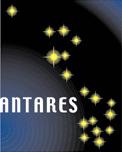Determining distances to individual galaxies using a variety of
methods is a fundamental part of mapping out the distribution of
galaxies in the Universe.
Rami Rekola has just
completed a PhD thesis at Tuorla Observatory, which focussed on the
issue of distances to nearby galaxies, and supervised by Chris Flynn
and Mauri Valtonen. Rami used three very different techniques with
which to measure distances: the first based on the brightness of
small, ionized spheres of gas in the galaxies, called planetary
nebula; the second, a classical technique, of using the brightness of
pulsating, luminous stars called cepheids; and the third, a method
based on the variations in brightness from place to place within a
high quality image of a galaxy.

| Part of the
giant spiral galaxy IC 342. It lies just beyond our own Local Group of
Galaxies in another group called Maffei Group or IC342/Maffei Group.
The image above is a combination of images taken with BVRI filters
(roughly blue, visual = green, red, and infrared) by Rami Rekola and
Kari Nilsson at the Nordic Optical Telescope. |
Distances have been obtained for dwarf elliptical and irregular galaxies of
the extended local group using the NOT,
in collaboration with Helmut Jerjen at
Mount Stromlo Observatory. A Cepheid based distance has been obtained for
IC 342, a large, starburst spiral galaxy, for which few (and contradictory)
distance estimates exist in the literature, using observations with the NOT over a long baseline (5 years).
Planetary nebulae have been used to make a distance determination to NGC 253
(using imaging data from the ESO 3.6 meter).
Rami Rekola's work is part of a longer term program to assemble
reliable masses and distances for the extended local group galaxies
with a view to simulating their dynamics. Many of these galaxies are
at distances where the effects of "dark
energy" on the Hubble flow are first noticable; accurate distances
to the galaxies are therefore of particular interest. The surface
brightness fluctuation method has been shown to be a particularly
efficient means of determining good distances, especially for dwarf
galaxies for which other methods cannot be easily applied. We are
planning to use the method to measure distances for large numbers of
nearby dwarfs in an ongoing effort to understand better the local
Hubble flow.
For further information:
Chris Flynn
Tuorla
Observatory
Väisäläntie 20
FIN-21500 Piikkiö
Finland
Tel: +358 (0)2 2744244
Fax: +358 (0)2 2433767
email: cflynn@astro.utu.fi
|
|

Research supported by the
ANTARES program of the Academy of
Finland
|